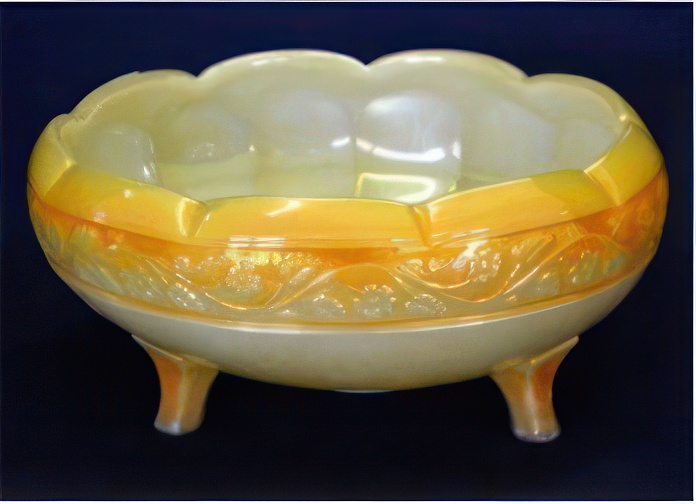Floral and Optic
By Don Chamberlain
A number of years ago we attended an auction at a nearby auction house that we had attended regularly for quite some time. At that time we were not only buying carnival glass for ourselves, but also other antiques to resell. On one of the tables sat an aqua/teal Floral and Optic rosebowl. I told Barb that I thought it was quite nice, and I thought that we should bid on it. She agreed, and we waited for it to be sold. When the bidding finally started on that piece, the ring man held it up and the auctioneer called it stretch glass. (We were surprised that he knew what it was.) We knew that stretch glass and carnival people both claimed the right to bid on it.
We did end up getting it for a reasonable price. Although it is not considered a highly prized piece, for many years it remained one of my favorite pieces.

The color on this rosebowl is different enough that people sometimes refer to it as teal or aqua since they can’t really put a definitive color on it. Perhaps there were two different colors made with slight changes to the formulas used for glass.

Above is the normally seen bowl shape.
The floral pattern is found in a band near the top of the outside of the piece, and the optic pattern is on the interior in the form of panels. This pattern is found on bowls, rosebowls, and ten and one-half to eleven inch chop or cake plates. All three were made from the bowl shape and all are three-footed.
Floral and Optic is one of the few Imperial patterns that are available in red. For some reason, bowls were made in the most colors. These colors are clambroth, marigold, marigold on milk glass, purple, red, smoke, aqua/teal, and white. Purple is considered the rarest, and red is the next hardest color to find.

You see the floral band near the top on the outside while the optic or paneled pattern is on the inside. A purple Floral and Optic bowl is the real prize in collecting this pattern.
The chop or cake plates appear to be found in the next most plentiful colors. My research included clambroth, marigold, marigold on milk glass, red, smoke, aqua/teal and white. I could find no listing for purple, and there is only one example of marigold on milk glass plate listed as selling.

On the left is this scarce marigold on milk glass plate shows the optic pattern clearly. On the right is the Floral and Optic in white isn’t found as often as some of the other colors. This plate has a nice display of iridescent colors.

Chop plates/cake plates are quite easily found in marigold, but finding a red one like this creates quite a challenge. Note the three little feet that support the plate, as well as the other pieces in this pattern.
The availability of rose bowls in a variety of colors would finish third. They are listed in aqua/teal, clambroth, marigold, marigold on milk glass, and smoke. Aqua/teal seems to lead the way as most desirable.
It seems strange that there are fewer colors available for rose bowls, if they were in fact made from the nine-inch bowls. It also is unusual that there were no rose bowls or plates made in purple. Dean and Diane Fry also state that this pattern is known in celeste blue which might have been interpreted by the person seeing the piece (many of us have trouble differentiating aqua, teal, and celeste).

Shown above is a scarce Floral and Optic rosebowl in marigold on milk glass.
In the Imperial Glass catalog reprint book compiled by Margaret and Douglas Archer, it is also interesting to note that certain pieces were being listed for sale as a unit. On page 41 of their book, there is pictured a special lot, number 2097, assorted three-footed salads in two shapes—eight and one-half inch salad or fruit bowls and an eight-inch salad or flower bowl (rose bowl) in rubigold and sapphire. On page 42 of the same book, there is a special lot number 2074 that includes a three piece console set. This features an eight and one- half inch salad bowl and seven-inch candlesticks which are not the same pattern of course. They are the Chesterfield pattern.

As you see in the original Butler Brother’s advertisement, most of the Floral and Optic shapes are shown grouped with a few other plainer patterns. One shape that isn’t shown is a rolled edge bowl. We saw one recently but didn’t have a camera.

Above you see an ice cream shape bowl which is listed in the ad, above, as a three footed shallow bowl.
Does anyone know of any rose bowls or plates that are known in purple? If so, I would like to know. Please send a photo, if possible. I will report it in a future issue of The Carnival Pump to dbcham@iowatelecom.net or 124 E. Honey Creek Dr., Manchester, IA.
Information for this article was obtained from Dave Doty’s website and Carnival Glass 101, as well as the Imperial reprint book listed in this article.
Photos provided by Seeck Auctions and the editor.
This article first appeared in the ICGA Pump in the June 2018 issue and is reprinted with permission.
